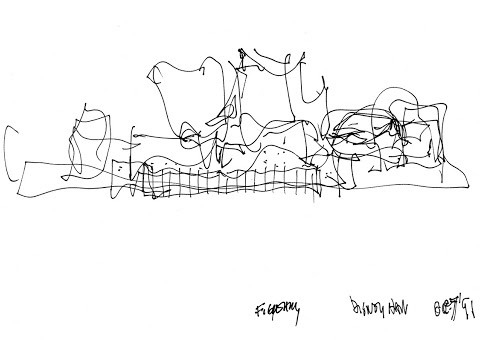Renders: Seeing is Believing
- Abby Doyle

- Aug 11, 2022
- 4 min read
Designers, architects and contractors have a special skill that most people do not: the ability to literally 'see' potential and options where others cannot. Taken a step further, it is the ability to communicate that vision with others that is vital to completing projects. Communication happens through plans, mood boards, material samples and hand sketches. However, when a client still cannot see the design, things can begin falling through the cracks in the line of communication. This can result in business deals falling through because the client cannot understand, or have faith in, your end results.

The first step is to convey the idea: some of the best known architecture started out as a scribble on the back of a napkin.
Frank Gehry, the architect that is known for designs such as the Walt Disney Concert Hall or the Guggenheim Museum Bilbao, is best known for his eccentric ideas and organic structures. He has been known to scribble lines that “only have meaning to him” and, with the help of his team, end up designing incredible buildings. The final results of these buildings always look eerily similar to his initial sketches (see pictures below for examples). Inspiration is in the eye of the beholder, but it is not often that others can see what is in your head. It is this disconnect between the vision and the client that can often make or break a proposal.
Whereas Gehry is known for his incredible designs, it did not start off that way. Initially, he had many meetings with many potential clients that ended in rejection. His ideas, although innovative and stunning, were not easily grasped by those not in the design field. In fact, his vague sketches and wild ideas cost him many projects. It was not until he found clients that appreciated his unique approach and trusted his skills that he was able to gain footing in the design world. Gehry lost many projects due to his inability to help the common person see what he could see.
The easier it is to convey an idea to the client, the higher the level of confidence they will have in your abilities.
Frank Gehry was not lacking in skill or talent, nor was he lacking in clients. Gehry just needed to find clients that would grant him the chance to show that his vision could be their successful reality – clients that could have an almost blind faith in his ability to perform. Not only was Gehry pitching wild, difficult-to-engineer designs, he was presenting lines and sketches that conveyed more emotion than measurements.
Not commonly known, Frank Gehry is as invested in the functionality of the space, as he is in pushing the boundaries of what is possible. While visually less traditional, the functionality of the interior was a massive priority to him as well. Had this side of design been the first thing he conveyed, then he may have landed more jobs. Being able to convey understanding and knowledge of what the client wants in the design, is what can make or break a project.
Visions, concepts, hand sketches, doodles and rough iterations are not things that should be eliminated from a project. In fact, the use of these tools are actually encouraged.
Design does not spring from nothing. In fact, most designers need pen and trace paper to think out loud. It is a vital part of the design process to be able to sketch and show ideas quickly. Being able to pull together mood boards and rough drafts will convey a vision to the client - and this is key. The difference between rendering and hand sketching is one shows inspiration while the other shows precision.
Not only will the utilization of these skills will help us see the picture you have envisioned, we can take these sketches and translate them into something a client will understand more easily. Through digital modeling, rendering and graphics, the communication of the project needs becomes clearer – allowing the client to have faith in the process by showing the exact plan in real time. Instead of relying solely on sketches and mood boards to pitch an idea, skip to the end and show them exactly what you plan on building. From the exact neighborhood or terrain, to the specific materials, you can showcase precisely what you plan.
With the rise of technology, the need for blind faith is gone.
That does not mean that the need for rough scribbles are gone. In fact, they are still encouraged. Thanks to technology, we are now able to begin eliminating the need for blind faith that clients must have to see a project come to life. With assets like 3D Modeling and Rendering, people can see exactly what they will be getting. From exact lights to specified flooring, a client can see the exact plan down to the tiniest details.
By showing the vision clearly, it allows the client to take a step back and trust that what is being shown, is what will be provided. It allows them a glimpse of the end result and helps further instill confidence in the trust that they have put in you. This is beneficial to both parties as the clients do not need to micromanage, and the contractors can simply produce. It frees up both sides to focus on what it is that they do best: moving the project along and saving both time and money for all.
Modeling and rendering are more than just adding pretty pictures to a project -
they add confidence that you understand what the client wants, and that you are the one to produce it for them.
#3dmodeling #rendering #graphics #design #virtualreality #realestate #architecture #construction #designers #interiordesigners #interiordesign #landscaping #virtualexperience #prototype #designtoday #digitalstorefront #digitalstore #virtualreality #virtualshopping #onlineshopping #frankgehry #architects #disney








Comments